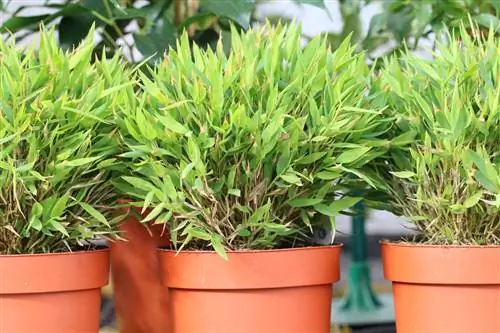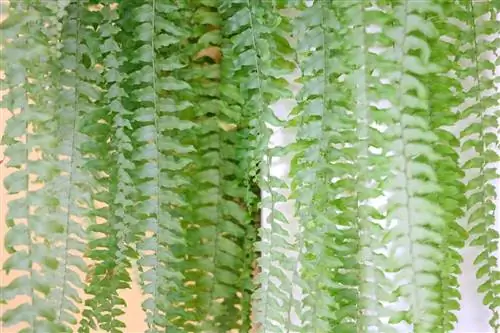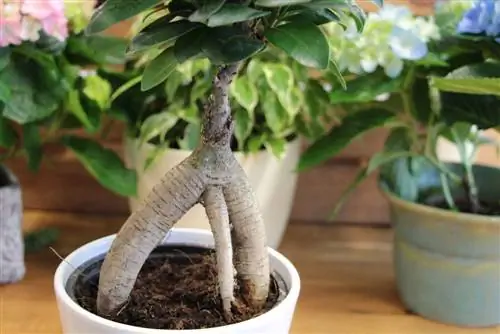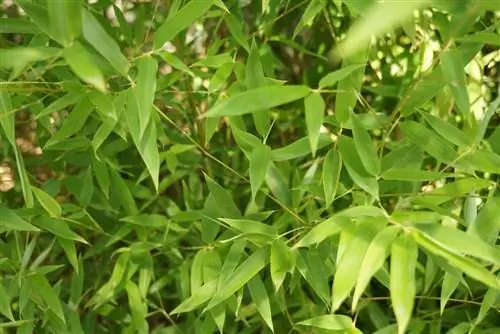- Author admin [email protected].
- Public 2023-12-17 03:39.
- Last modified 2025-01-24 12:45.
Contrary to its name, the indoor bamboo does not belong to the bamboo plants, but to the sweet grasses. Nevertheless, it impresses with its similar shape, which, however, comes with high care requirements.
Indoor bamboo profile
- Growth height: 60 centimeters
- Growth habit: bushy
- Growth direction: upright
- Leaves: evergreen
- Leaf shape: elongated and grass-like
- Leaf color: green
- Flowering period: June to August
- Flower shape: ear
- Flower color: yellow
- Toxicity: Yes, but only as young plants
Location Requirements
An optimal location is the basis for a he althy and well-growing plant, which is why the choice of location is of particular importance.
The chosen spot should be in a sunny spot, but protected from the midday sun. This leads to irreparable burns on the leaves over a short period of time. The room temperature should ideally be 21 degrees Celsius, although temperatures in the range of 18 to 25 degrees Celsius can be easily tolerated. Tropical indoor bamboo cannot tolerate temperatures below 15 degrees Celsius and will cause the plant to die.
Note:
If the outside temperature is appropriate, the bamboo can also be kept outside in summer, although here too the minimum temperature should not be less than 15 degrees Celsius. In addition, the location should be in a place protected from wind and rain.

Substrate selection
Pogonatherum paniceum prefers a well-drained and nutrient-rich substrate. Layers of earth that are too compacted lead to reduced water drainage and thus to waterlogging, which is very poorly tolerated and often leads to dangerous root rot.
The combination of different individual materials has therefore proven successful in practice:
- Garden soil
- gravel
- Sand
- Granules
- Coconut fibers
Planting
Due to its sensitivity to temperature, the indoor bamboo is mainly cultivated in pots. The optimal planter should be at least twice as wide as the root ball to provide enough space for the extensive root system. To make repotting easier later, we recommend lining the pot with plastic film before filling the substrate, with several holes in the lower area for the excess water to drain away.
When planting, it is also important to ensure that both the trunk and around a quarter of the root ball protrude from the soil to prevent excessive moisture.
Repotting
Especially due to the constant growth, an annual repotting into a larger planter is urgently required. The next larger pot should be at least two centimeters larger in diameter than the previous one in order to provide the indoor bamboo with enough space to grow. When removing the plant from the currently occupied pot, most of the substrate on the roots should be removed. This enables a detailed examination and shortening of the root area if decay processes or other injuries have occurred.
The appearance of root rot is a sign of a substrate that is too moist, and repotting is an optimal opportunity to improve the situation.
Possible activities to improve water drainage are:
- inserting a drainage
- setting drainage holes in the bottom of the pot
- Addition of gravel or expanded clay
Finally, Pogonatherum paniceum is transplanted into the new container and watered extensively to stimulate rooting.
Propagation
There are a total of three methods to choose from for propagating Pogonatherum paniceum, all of which are considered promising. In addition to dividing the root ball and separating a root runner, sowing has also become established.
Sowing new plants is done using the harvested ears of corn, which are sown in a seed tray. With sufficient watering, small young plants will be present after just six weeks, which can be pricked out to a height of ten centimeters.
Growing through the roots is particularly useful when repotting, as the plant has to be removed from its planter. The process then looks like this:
- Remove the root ball generously from substrate
- Divide the root ball into a maximum of two parts with a sharp knife
- Transplant partial areas into their own pots
Note:
Propagation via a division form also ensures a renewed growth spurt in the mother plant and thus contributes to the he alth of the plant.
Pouring routine
In addition to the previously mentioned waterlogging, the bamboo also tolerates drought very poorly, which is why consistent watering has proven to be effective. Using a finger test you can quickly and easily determine how moist the soil substrate is. If the soil is dry to a depth of three centimeters, i.e. about the length of a finger, watering is necessary. Another characteristic of excessive dryness is the curling of the leaves.
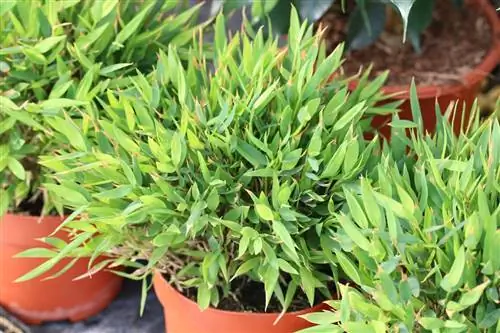
As a supplement to regular watering of the root ball, we also recommend spraying the above-ground parts of the plant in order to keep the surrounding air moist at the same time.
Due to lime intolerance, the following liquids are suitable for irrigation and spraying:
- stale tap water
- filtered water
- Rainwater
Tip:
An alternative to spraying is showering the plant, but this should only be done at most once a month to avoid waterlogging.
Fertilizer rules
Pogonatherum paniceum is a houseplant that has high nutrient requirements. It is therefore necessary to provide them with fertilizer regularly to support consistent growth. In addition, a nutrient deficiency is characterized by wilted leaves as well as discoloration and deformation. Nitrogen, phosphorus and potassium are particularly necessary for balanced growth.
In addition, please note when fertilizing:
- Period: Spring to Autumn
- Interval: biweekly
- Method: liquid fertilizer together with irrigation water
Cut
Due to its natural bushy growth, pruning the indoor bamboo is only necessary in exceptional cases. The majority of pruning measures involve dried shoots and stalks that have grown undesirably. Conventional household scissors are completely sufficient as a cutting tool, although additional gloves provide protection from the sharp edges of the leaves. The best time for large-scale pruning is spring, whereas dried plant parts should be removed all year round.
Wintering
The indoor bamboo is not hardy and must therefore be overwintered in a frost-free place. The reduced amount of light in winter causes the plant to rest, so that the amount of watering can be significantly reduced. In addition, the application of fertilizer should be stopped completely until next spring to avoid oversupply.
Care errors and pests
Basically, Pogonatherum paniceum is very robust against diseases and pests. However, incorrect care in particular leads to a weakened plant, which in turn is susceptible to any diseases.
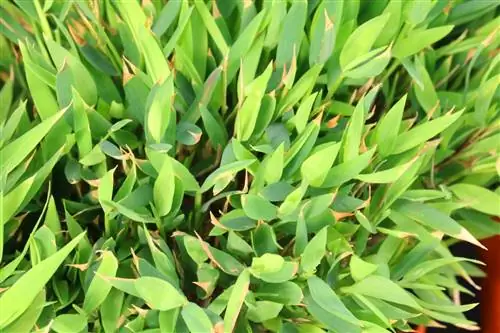
Making errors
Root rot is one of the most common diseases of indoor bamboo and is caused by a substrate that is too moist in combination with a room temperature that is too low. It is precisely these conditions that are optimal for the spread of the bacteria and fungi responsible for the putrefaction, which spread via spores. By attacking the sensitive roots, the absorption of nutrients by the plant itself is prevented. As a result, wilted and discolored leaves appear despite adequate watering, which is a clear indication of root rot. The further steps for treatment are as follows:
- Unpotting the plant
- Remove rotten root areas generously
- Prepare new planter with fresh substrate
- Repotting the plant
In order to prevent the spores from spreading further, it is absolutely necessary to stop watering the indoor bamboo for at least two weeks. This causes the remaining spores to die and gives the plant enough time to recover.
Spider mites
In particular, already weakened plants offer an optimal breeding ground for infestation by pests, which also include spider mites. In general, however, bamboo only serves as a temporary home for many insects and for spreading to a neighboring houseplant. Nevertheless, a pest infestation should never be taken lightly, but should be treated appropriately.
Combat
The first step is to give the plant a vigorous shower, which should wash away most of the adult animals. The majority of sticky eggs can be removed from the leaves using a damp cloth. After carrying out the above procedure, the indoor bamboo should be covered with a transparent plastic bag. This ensures a significantly more humid indoor climate, which in turn contributes to the death of the remaining insects.
Other proven home remedies for spraying the plant are:
- Mixture of soap and water (ratio 1:70)
- Mixture of spirit and water (ratio 1:70)
- Neem oil

